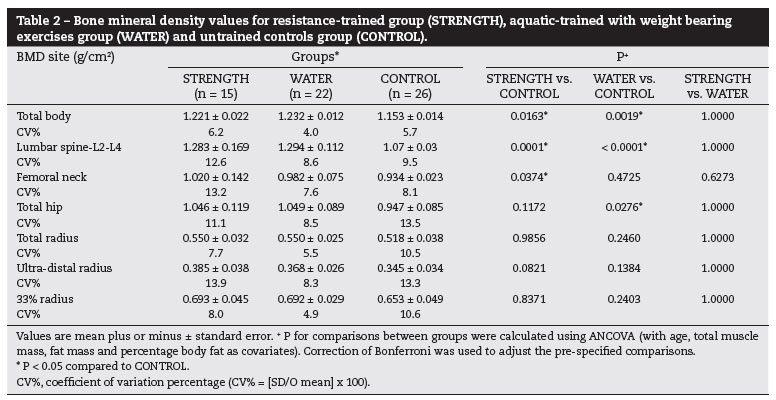INTRODUCTION: Many studies have shown that resistance training has a positive effect on bone mineral density (BMD). However, few studies have compared the BMD of individuals undergoing resistance training and those training aquatic weight-bearing exercises. OBJECTIVE: To compare, in a cross-sectional study, the BMD of postmenopausal women undergoing resistance training and postmenopausal women training aquatic weight-bearing exercises. METHODS: The sample comprised 63 women divided into the following three groups: resistance training (STRENGTH: n = 15; 51.4 ± 2.7 years); aquatic weight-bearing exercises (WA-TER: n = 22; 54.5 ± 3.3 years); and non-trained controls (CONTROL: n = 26; 52.0 ± 3.3 years). All volunteers were on hormone replacement therapy for at least one year. The STRENGTH and WATER groups were training for at least one year prior to study beginning (mean years of training - STRENGTH: 4.5 ± 2.0; WATER: 4.2 ± 2.2). RESULTS: The STRENGTH group had higher BMD of total body, femoral neck, lumbar spine L2-L4 as compared with the CONTROL group (all P < 0.05). The WATER group had higher BMD of total body, total hip, lumbar spine L2-L4 as compared with the CONTROL group (all P < 0.05). However, no difference was observed between the STRENGTH and WATER groups regarding the sites assessed. CONCLUSIONS: Those findings suggest that not only the resistance training, but also aquatic weight-bearing exercises might be a non-pharmacological strategy to prevent BMD loss in postmenopausal women.
Strength training; Aquatic weight-bearing exercises; Bone density; Postmenopause



